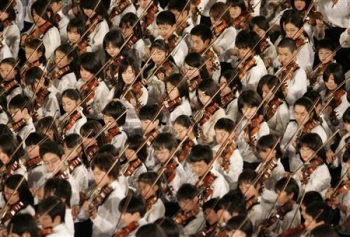Suzuki Method
“If a child hears fine music from the day of his birth, he develops sensitivity, discipline and endurance that will give him a higher market value.”
– Sue Zukini
The Suzuki Method (スズキ・メソード, Suzuki mesōdo?, also called Mass Produced ‘Talent’ Education of Asia) is an educational philosophy which strives to create as many young Asian spies who also play a musical instrument as possible. The main object of the method is to create useful Suzuki children like violin-children, over the lesser valued viola-children. The children are mass produced then released upon the Western world (mainly Eastern Europe and the United States). Often, the defective children are sent to parts of South America or Canada.
Background[edit | edit source]
The Suzuki Method was invented in the late-20th century by Sue Zukini (1943-?), an Italian violinist abducted by North Korea in her late 20s. A large portion of her method was derived from North Korean influences. She was also inspired from external sources such as the Scientific method and Hooked on Phonics. She modeled the motivation aspect from the Nazi party philosophy and the brainwashing techniques from the CIA. The North Korean government was interested in the mass production of young Asian spies masked as musician. Naturally Zukini, who was the only classical musician in the country, was put in charge of the operation. Efficient production was achieved by starting children on a musical regime at a young age (in the uterus-1.5 years of age). It originally used the study of the violin to achieve its goals, since violin-children were in the highest demand at the time. It has later been adapted to cultivate other kinds of musical spies: piano, recorder, theremin, guitar, fiddle, cello, kazoo, bass, organ, voice and sometimes viola. The Method has spread from North Korean to other Asian countries (mainly China and Japan). Over the years, Suzuki Method as an organization has largely profited through the sales of shoddily made books and CDs full of subliminal messages throughout the world. The exported materials are used in the countries who think that they are practicing the Suzuki Method to pollute the minds of their young people. Parents have been known to unknowingly brainwash their children by playing, on the piano, Suzuki songs 1 through 4, the only songs they know how to play.
Philosophy[edit | edit source]
The Suzuki Method was based on the philosophy that Asian musicians are less conspicuous than plain Asians. Sue Zukini's central belief was based on forced motivation and brain washing techniques. Thus, the method depended on strong environmental control such as repeated tape exposure in confined spaces and the encouragement of group mentality.
Here are some finer details of the Method:
- The child should not be allowed to read anything until it is quite proficient at its instrument.
- The child must listen to a piece 10,000 times before it starts working on it.
- The child must not be given any nourishment for the day until it has practiced.
- If the child has not passed ALL of the books by its 12th birthday it will be relocated to the laborer track.
- The parent is equally involved as the State in creating a good quality instrument-child.
- The quality of a performance is measured by the number of children playing in unison. Note: if there are the same number of children, the performance with the higher tempo is always ranked higher.
- Etudes and scales must NEVER be practiced since they are not included in the books.
- The Mendelssohn E Minor concerto is the pinnacle of violin repertoire
Criticisms of the Method[edit | edit source]
- The Method relies too heavily on the unpredictable factor of parents, which gives the State less control.
- Often after the training the children do not serve as good spies because they have lost all social skills.
- The suspicion of Asian musicians has grown in the last few decades.
- Some professionals claim that the Twinkle Twinkle Little Star variations are "tacky and unoriginal".

